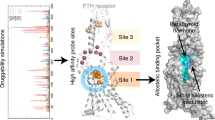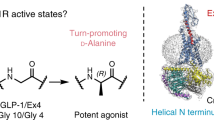Abstract
Computational prediction of the effects of residue changes on peptide-protein binding affinities, followed by experimental testing of the top predicted binders, is an efficient strategy for the rational structure-based design of peptide inhibitors. In this study we apply this approach to the discovery of competitive antagonists for the secretin receptor, the prototypical member of class B G protein-coupled receptors (GPCRs). Proteins in this family are involved in peptide hormone-stimulated signaling and are implicated in several human diseases, making them potential therapeutic targets. We first validated our computational method by predicting changes in the binding affinities of several peptides to their cognate class B GPCRs due to alanine replacement and compared the results with previously published experimental values. Overall, the results showed a significant correlation between the predicted and experimental ΔΔG values. Next, we identified candidate inhibitors by applying this method to a homology model of the secretin receptor bound to an N-terminal truncated secretin peptide. Predictions were made for single residue replacements to each of the other nineteen naturally occurring amino acids at peptide residues within the segment binding the receptor N-terminal domain. Amino acid replacements predicted to most enhance receptor binding were then experimentally tested by competition-binding assays. We found two residue changes that improved binding affinities by almost one log unit. Furthermore, a peptide combining both of these favorable modifications resulted in an almost two log unit improvement in binding affinity, demonstrating the approximately additive effect of these changes on binding. In order to further investigate possible physical effects of these residue changes on receptor binding affinity, molecular dynamics simulations were performed on representatives of the successful peptide analogues (namely A17I, G25R, and A17I/G25R) in bound and unbound forms. These simulations suggested that a combination of the α-helical propensity of the unbound peptide and specific interactions between the peptide and the receptor extracellular domain contribute to their higher binding affinities.





Similar content being viewed by others
References
Hopkins AL, Groom CR (2002) The druggable genome. Nat Rev Drug Discov 1(9):727–730
Hoare SRJ (2005) Mechanisms of peptide and nonpeptide ligand binding to Class B G-protein-coupled receptors. Drug Discov Today 10(6):417–427
Parthier C et al (2009) Passing the baton in class B GPCRs: peptide hormone activation via helix induction? Trends Biochem Sci 34(6):303–310
Underwood CR et al (2010) Crystal structure of glucagon-like peptide-1 in complex with the extracellular domain of the glucagon-like peptide-1 receptor. J Biol Chem 285(1):723–730
Pioszak AA, Xu HE (2008) Molecular recognition of parathyroid hormone by its G protein-coupled receptor. Proc Natl Acad Sci USA 105(13):5034–5039
Parthier C et al (2007) Crystal structure of the incretin-bound extracellular domain of a G protein-coupled receptor. Proc Natl Acad Sci USA 104(35):13942–13947
Pioszak AA et al (2008) Molecular recognition of corticotropin-releasing factor by its G-protein-coupled receptor CRFR1. J Biol Chem 283(47):32900–32912
Runge S et al (2008) Crystal structure of the ligand-bound glucagon-like peptide-1 receptor extracellular domain. J Biol Chem 283(17):11340–11347
Igarashi H et al (2002) Elucidation of the vasoactive intestinal peptide pharmacophore for VPAC2 receptors in human and rat and comparison to the pharmacophore for VPAC1 receptors. J Pharmacol Exp Ther 303(2):445–460
Dong M et al (2011) Importance of each residue within secretin for receptor binding and biological activity. Biochem 50(14):2983–2993
Dean T et al (2006) Role of amino acid side chains in region 17–31 of parathyroid hormone (PTH) in binding to the PTH receptor. J Biol Chem 281(43):32485–32495
Adelhorst K et al (1994) Structure-activity studies of glucagon-like peptide-1. J Biol Chem 269(9):6275–6278
Nicole P et al (2000) Identification of key residues for interaction of vasoactive intestinal peptide with human VPAC1 and VPAC2 receptors and development of a highly selective VPAC1 receptor agonist. J Biol Chem 275(31):24003–24012
Kortemme T, Baker D (2002) A simple physical model for binding energy hot spots in protein–protein complexes. Proc Natl Acad Sci USA 99(22):14116–14121
Kortemme T, Kim DE, Baker D (2004) Computational alanine scanning of protein–protein interfaces. Sci STKE 219:12
Bordner AJ, Abagyan RA (2004) Large scale prediction of protein geometry and stability changes for arbitrary single point mutations. Proteins: Struct Funct Bioinform 57(2):400–413
Abagyan R, Totrov M (1994) Biased probability Monte Carlo conformational searches and electrostatic calculations for peptides and proteins. J Mol Biol 235(3):983–1002
Cohen M et al (2008) Similar chemistry, but different bond preferences in inter versus intra protein interactions. Proteins: Struct Funct Bioinform 72(2):741–753
Dong M et al (2011) Lactam constraints provide insights into the receptor-bound conformation of secretin and stabilize a receptor antagonist. Biochem 50(38):8181–8192
Rose PW et al (2011) The RCSB Protein Data Bank: redesigned web site and web services. Nucleic Acids Res 39(suppl 1):D392–D401
Abagyan R, Totrov M, Kuznetsov D (1994) ICM-A new method for protein modeling and design: applications to docking and structure prediction from the distorted native conformation. J Comput Chem 15(5):488–506
Momany FA et al (1975) Energy parameters in polypeptides. VII. Geometric parameters, partial atomic charges, nonbonded interactions, hydrogen bond interactions, and intrinsic torsional potentials for the naturally occurring amino acids. J Phys Chem 79(22):2361–2381
Nemethy G, Pottle MS, Scheraga HA (1983) Energy parameters in polypeptides. 9. Updating of geometrical parameters, nonbonded interactions, and hydrogen bond interactions for the naturally occurring amino acids. J Phys Chem 87(11):1883–1887
Nemethy G et al (1992) Energy parameters in polypeptides. 10. Improved geometrical parameters and nonbonded interactions for use in the ECEPP/3 algorithm, with application to proline-containing peptides. J Phys Chem 96(15):6472–6484
Abagyan R (1997) Protein structure prediction by global energy optimization. In: van Gunseteren WF, Weiner PK, Wilkinson AJ (eds) Computer simulation of biomolecular systems: theoretical and experimental applications. Kluwer, Norwell, MA, pp 363–394
Ulrich CD 2nd et al (1993) Intrinsic photoaffinity labeling of native and recombinant rat pancreatic secretin receptors. Gastroenterology 105(5):1534
Munson PJ, Rodbard D (1980) Ligand: a versatile computerized approach for characterization of ligand-binding systems. Anal Biochem 107(1):220–239
Van Der Spoel D et al (2005) GROMACS: fast, flexible, and free. J Comput Chem 26(16):1701–1718
Lindorff Larsen K et al (2010) Improved side chain torsion potentials for the Amber ff99SB protein force field. Proteins: Struct Funct Bioinform 78(8):1950–1958
Jorgensen WL et al (1983) Comparison of simple potential functions for simulating liquid water. J Chem Phys 79(2):926–935
Berendsen HJC et al (1984) Molecular dynamics with coupling to an external bath. J Chem Phys 81(8):3684–3690
Parrinello M, Rahman A (2009) Polymorphic transitions in single crystals: a new molecular dynamics method. J Appl Phys 52(12):7182–7190
Hess B et al (1997) LINCS: a linear constraint solver for molecular simulations. J Comput Chem 18(12):1463–1472
Essmann U et al (1995) A smooth particle mesh Ewald method. J Chem Phys 103(19):8577–8593
Pozvek G et al (1997) Structure/function relationships of calcitonin analogues as agonists, antagonists, or inverse agonists in a constitutively activated receptor cell system. Mol Pharmacol 51(4):658
Robberecht P, Conlon TP, Gardner JD (1976) Interaction of porcine vasoactive intestinal peptide with dispersed pancreatic acinar cells from the guinea pig. Structural requirements for effects of vasoactive intestinal peptide and secretin on cellular adenosine 3′: 5′-monophosphate. J Biol Chem 251(15):4635
Turner JT, Jones SB, Bylund DB (1986) A fragment of vasoactive intestinal peptide, VIP (10–28), is an antagonist of VIP in the colon carcinoma cell line, HT29. Peptides 7(5):849–854
Bodanszky M et al (1978) Synthesis and some pharmacological properties of the 23-peptide 15-lysine-secretin-(5–27). Special role of the residue in position 15 in biological activity of the vasoactive intestinal polypeptide. J Med Chem 21(11):1171–1173
Gardner JD et al (1979) Interaction of secretin 5–27 and its analogues with hormone receptors on pancreatic acini. Biochim Biophys Acta 583(4):491–503
Robberecht P et al (1988) Secretin receptors in human pancreatic membranes. Pancreas 3(5):529–535
Potapov V, Cohen M, Schreiber G (2009) Assessing computational methods for predicting protein stability upon mutation: good on average but not in the details. Protein Eng Des Sel 22(9):553–560
Benedix A et al (2009) Predicting free energy changes using structural ensembles. Nat Methods 6(1):3–4
Yin S, Ding F, Dokholyan NV (2007) Eris: an automated estimator of protein stability. Nat Methods 4(6):466–467
Kellogg EH, Leaver Fay A, Baker D (2011) Role of conformational sampling in computing mutation induced changes in protein structure and stability. Proteins: Struct Funct Bioinform 79(3):830–838
Runge S et al (2003) Different domains of the glucagon and glucagon like peptide 1 receptors provide the critical determinants of ligand selectivity. Br J Pharmacol 138(5):787–794
Kabsch W, Sander C (1983) Dictionary of protein secondary structure: pattern recognition of hydrogen-bonded and geometrical features. Biopolymers 22(12):2577–2637
Acknowledgments
The authors thank Mary Lou Augustine and Delia I. Pinon for their excellent technical assistance and the Mayo Clinic Research Computing Services and the Arizona State University Advanced Computing Center for computational resources. This work was supported by the Mayo Clinic and a grant from the National Institutes of Health (DK46577).
Author information
Authors and Affiliations
Corresponding author
Electronic supplementary material
Below is the link to the electronic supplementary material.
Rights and permissions
About this article
Cite this article
Te, J.A., Dong, M., Miller, L.J. et al. Predicting the effects of amino acid replacements in peptide hormones on their binding affinities for class B GPCRs and application to the design of secretin receptor antagonists. J Comput Aided Mol Des 26, 835–845 (2012). https://doi.org/10.1007/s10822-012-9574-x
Received:
Accepted:
Published:
Issue Date:
DOI: https://doi.org/10.1007/s10822-012-9574-x




